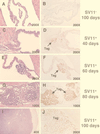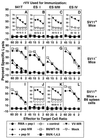Cytotoxic T-lymphocyte epitope immunodominance in the control of choroid plexus tumors in simian virus 40 large T antigen transgenic mice
- PMID: 10364350
- PMCID: PMC112659
- DOI: 10.1128/JVI.73.7.5981-5993.1999
Cytotoxic T-lymphocyte epitope immunodominance in the control of choroid plexus tumors in simian virus 40 large T antigen transgenic mice
Abstract
The simian virus 40 (SV40) large tumor antigen (Tag) is a virus-encoded oncoprotein which is the target of a strong cytotoxic T-lymphocyte (CTL) response. Three immunodominant H-2(b)-restricted epitopes, designated epitopes I, II/III, and IV, have been defined. We investigated whether induction of CTLs directed against these Tag epitopes might control Tag-induced tumors in SV11(+) (H-2(b)) mice. SV11(+) mice develop spontaneous tumors of the choroid plexus due to expression of SV40 Tag as a transgene. We demonstrate that SV11(+) mice are functionally tolerant to the immunodominant Tag CTL epitopes. CTLs specific for the H-2Kb-restricted Tag epitope IV were induced in SV11(+) mice following adoptive transfer with unprimed C57BL/6 spleen cells and immunization with recombinant vaccinia viruses expressing either full-length Tag or the H-2Kb-restricted epitope IV as a minigene. In addition, irradiation of SV11(+) mice prior to adoptive transfer with unprimed C57BL/6 spleen cells led to the priming of epitope IV-specific CTLs by the endogenous Tag. Induction of epitope IV-specific CTLs in SV11(+) mice by either approach correlated with increased life span and control of the choroid plexus tumor progression, indicating that CTLs specific for the immunodominant Tag epitope IV control the progressive growth of spontaneous tumors induced by this DNA virus oncogene in transgenic mice.
Figures








References
-
- Altman J D, Moss P A H, Goulder P J R, Barouch D H, McHeyzer-Williams M G, Bell J I, McMichael A J, Davis M M. Phenotypic analysis of antigen-specific T lymphocytes. Science. 1996;274:94–96. - PubMed
-
- Antón L C, Yewdell J W, Bennink J R. MCH class I-associated peptides produced from endogenous gene products with vastly different efficiencies. J Immunol. 1997;158:2535–2542. - PubMed
-
- Bacik I, Cox J H, Anderson R, Yewdell J W, Bennink J R. TAP (transporter associated with antigen processing)-independent presentation of endogenously synthesized peptides is enhanced by endoplasmic reticulum insertion sequences located at the amino- but not carboxyl-terminus of the peptide. J Immunol. 1994;152:381–387. - PubMed
-
- Blaney J E, Jr, Nobusawa E, Brehm M A, Bonneau R H, Mylin L M, Fu T-M, Kawaoka Y, Tevethia S S. Immunization with a single major histocompatibility complex class I-restricted cytotoxic T-lymphocyte recognition epitope of herpes simplex virus type 2 confers protective immunity. J Virol. 1998;72:9567–9574. - PMC - PubMed
Publication types
MeSH terms
Substances
Grants and funding
LinkOut - more resources
Full Text Sources
Other Literature Sources
Molecular Biology Databases

